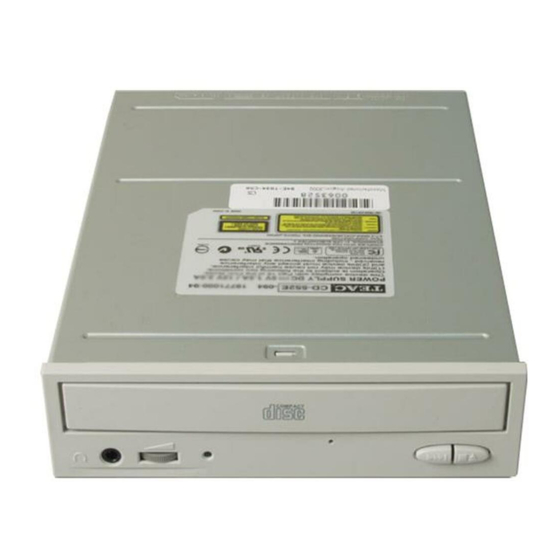
Table of Contents
Advertisement
Quick Links
CD-ROM Drive Installation Guide
Model CD-552E
disc tray
headphone jack
volume control
disc tray: Use the disc tray to load CDs into the drive. You can open and close
the tray by pressing the eject button.
Note: We strongly recommend that you do not push the tray in to close it.
Please press the eject button to eject or retract the tray.
headphone jack (3.5mm): You can connect headphones or external speakers
to this jack to listen to an audio CD being played on your TEAC drive. Use a 3.5
mm stereo mini-plug. For external speakers, connect a stereo adapter to split the
output into separate cables for the left and right channels. Such adapters convert
a male stereo mini-jack to two female phono jacks.
volume control: Use the volume control to adjust the volume. Turning the
control to the right increases the volume. Turning it to the left decreases the
volume. (Lower the volume before you start a CD-ROM audio program to
protect your hearing and the audio speakers.)
on/busy indicator: The drive features an LED indicator light on the front panel,
which indicates the seek, play, and read operations.
emergency eject mechanism: If the eject button fails, you can turn off the
power to the CD-ROM drive and insert a small, thin rod (such as a straightened
paper clip) into the emergency eject mechanism opening and press firmly to
eject the disc.
Caution: Do not attempt to use the emergency eject mechanism when the on/
busy indicator is lit or you may seriously damage the disc or the CD-ROM
drive.
play button: Press this button to play a music disc through the headphone jack.
eject button: Press this button to open or close the disc tray. (Some CD-ROM
titles disable the manual eject button and rely on software commands to eject the
disc. Refer to the documentation for these titles for more information.)
TEAC CD-ROM Installation Guide
(52X MAX)
IDE/ATAPI Interface
on/busy indicator
emergency eject
mechanism opening
1
play button
eject button
®
Advertisement
Table of Contents

Summary of Contents for Teac CD-552E
- Page 1 (3.5mm): You can connect headphones or external speakers to this jack to listen to an audio CD being played on your TEAC drive. Use a 3.5 mm stereo mini-plug. For external speakers, connect a stereo adapter to split the output into separate cables for the left and right channels.
- Page 2 Refer to Recommended System Requirements to ensure the drive’s proper 52X maximum performance. The TEAC 52X speed CD-ROM drive can read certain data up to 52 times faster than conventional speed CD-ROMs. It also plays lower speed titles at their respective speeds.
- Page 3 The CD-ROM drive features three pairs of jumper pins on the rear panel. By placing the jumper on the appropriate pair of pins, you can set the drive to Master, Slave, or CSEL mode. The factory default setting is the Slave position. TEAC CD-ROM Installation Guide...
- Page 4 Master (default) Installing the CD-ROM Drive This section explains how to install the TEAC CD-ROM Drive into an IBM PC or compatible personal computer. Follow the steps below and refer to your computer documentation for information specific to your system.
- Page 5 To eject a disc, press the eject button on the front of the drive to extend the disc tray. Remove the disc from the disc tray and store it in its protective case. Then press the eject button again to retract the disc tray back into the drive. TEAC CD-ROM Installation Guide...
- Page 6 Weight 1.98 lbs. Reliability MTBF 25,000 POH (Duty 25%) Technical Support TEAC America, Inc. (USA) Technical Support Telephone: (323) 727-4860 • Fax: (323) 869-8751 Monday - Friday 8:00 a.m. - 5:00 pm PST http://www.teac.com/DSPD/techsupport-America.htm E-mail: dspdtsg@teac.com TEAC CD-ROM Installation Guide...











Need help?
Do you have a question about the CD-552E and is the answer not in the manual?
Questions and answers